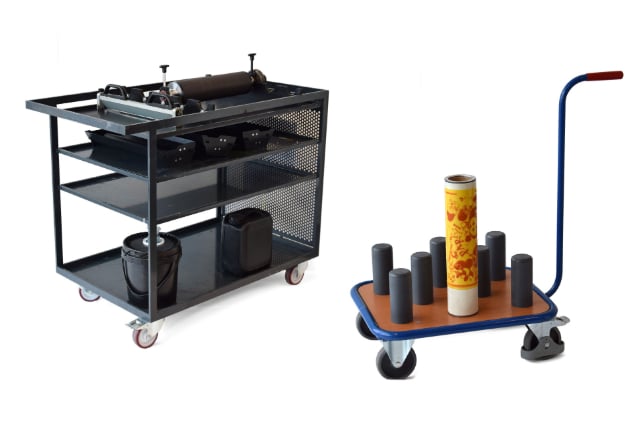Skilful makeready and job preparation helps reduce machine changeover time and allows you to start the next print job as quickly and efficiently as possible. This increases productivity and generates more income for the company.
There’s no set order to getting things ready for the next job. While the current job is running, your offsider (helper) or designated makeready technician should be aware and starting to think of the next job and what it requires upon start-up.
 MPS EFA Slide out ink drawer
MPS EFA Slide out ink drawer
To-do List for Pre- MakeReady
- Check with the supervisor to confirm the schedule (things can change or the next job might not be ready to go to press but it’s still on the schedule.)
- Get the job bag, plates, and die
- Obtain any additional tooling, embossing, hot or cold foil, rotary screen, laminating, etc.
- Mount the plates
- Get the inks ready
- Deliver stock (substrate to be printed), foil, laminating films, etc. to the press
- The die and magnetic cylinder should be at the press and mounted in the correct rewind direction
- Make sure ink trays and buckets, if required, are ready to go. Prepare pumps, if needed
- Check the chamber and/or doctor blades and replace, if needed
- Prepare anilox (keep in covers to protect from damage)
- Obtain anything required for next job like solvent, water, chemicals, rages, etc.
- Get the pallets, inner and outer boxes, and labels ready (The packers can get boxes ready and clean around the front of the press during wash up)
Preparing for the next job is done by the offsider but preparation shouldn’t interfere with the task at hand while the job is on the press.
Bins still need to be emptied, roll changes done, viscosity of inks and ink levels are all to be maintained during the process of next job preparation.
This may seem like a lot, but depending on the waste coming from printing and roll size, the roll changes and emptying the bin may be 1 or 2 times an hour, so there’s ample time to get the next job ready.
Unless you have a good system in place and a well-trained offsider, this can be challenging during short-run jobs. A good offsider that is keen to learn can be a great candidate for a new apprentice.
The next job’s makeready is not to be started before the job bag, paperwork or computer work, and wash up are completed. This helps prevent plates, history cards, colour standards, etc. from being mixed up and potentially misplaced or lost.

Makeready Tools and Accessories
Tools and accessories can have a big impact on preparing for the next job.
You’ll need the following tools and accessories to make the initial makeready setup easier and efficient:
- Wash up trolley
- Makeready trolley (Note: keep the wash up and makeready trolleys separate to avoid a messy environment)
- Dedicated work bench for the makeready tooling and inks
- Anilox and rubber roller (pan roller) racks
- Hand crane or gantry crane (gantry crane provides a faster and safer change of magnetic cylinders and slot dies)
- Designated area for all tooling, trolleys, and substrate. (Note: keep this area clean and organized)
Once all ink trays, inks, anilox, plates, tooling, and makeready paper is on, then it’s time to set the print on each unit in use, get the print in register, and set any embellishment and application.
Depending on what makeready stock you’re using, only some of these steps may apply. Because colour matching shouldn’t be done apart from the substrate used for the job, you can tape a small piece to the web to check the colour and adjust, if required.
 MPS EFS & EFA Automated Quick Change Die
MPS EFS & EFA Automated Quick Change Die
When you’re ready to move to the substrate required for the job, the die can then be set.
Don’t use the die on a substrate that it’s not made for as this can shorten the life span of the die or render it useless. If there’s no back-up die, then all the hard work making ready the job was all for nothing.
Final note about importance of pre-makeready checks
Sometimes, something can be overlooked or denied because the schedule was changed and not updated, or the materials were not available, etc. This is why pre-makeready checks are so important.
I’m sure almost every printer has experienced this ‘fail’ and had their job lifted during or just as they were about to prepare the makeready. This can be especially frustrating if it’s the same tooth size and the plates and die needs to be dismounted.
Always check with your Print Supervisor and/or Print Manager before to prevent these issues from arising as delivery dates are sometimes overlooked or promises are made to customers that affects the schedule and processes before a job gets to press. The use of Management Information Systems (MIS) can contribute to smooth operations from the start of a job and all the way to printing.
With the MIS, Big Data, Internet of Things (IoT), and other integrated systems on the MPS press and surrounding areas, this can be observed before it becomes an issue.
Learn more about Big Data and why it’s really important
I hope this has been helpful. If you have any questions or suggestions, you can always contact me via LinkedIn or via email k.marsh@mps4u.com.